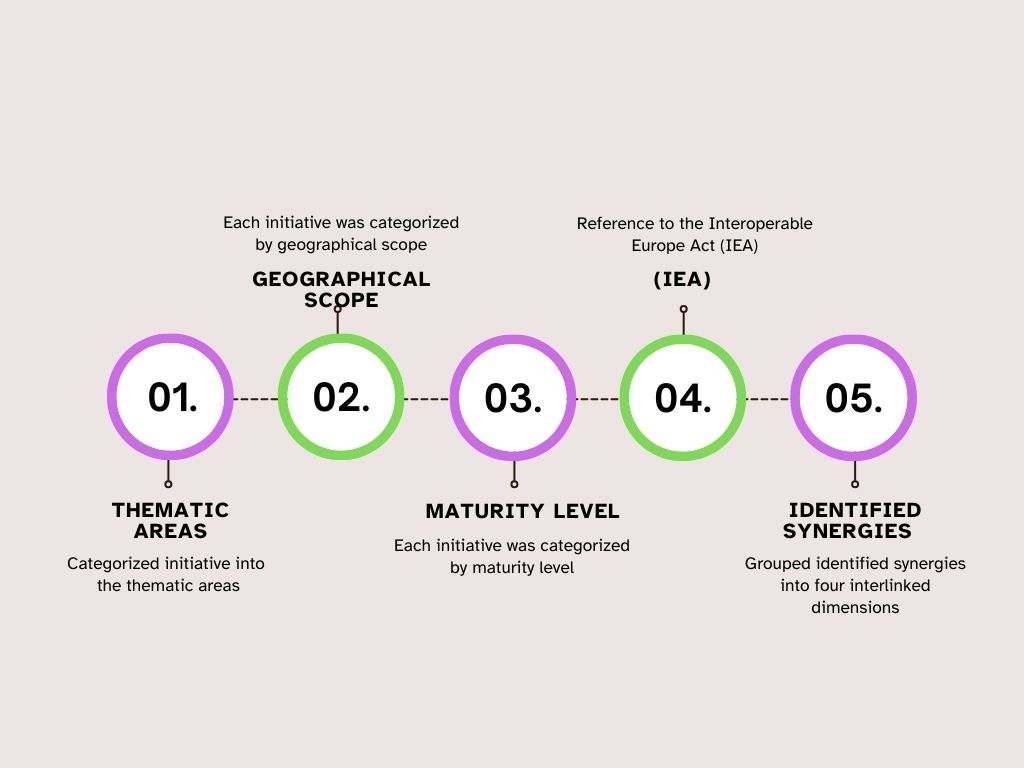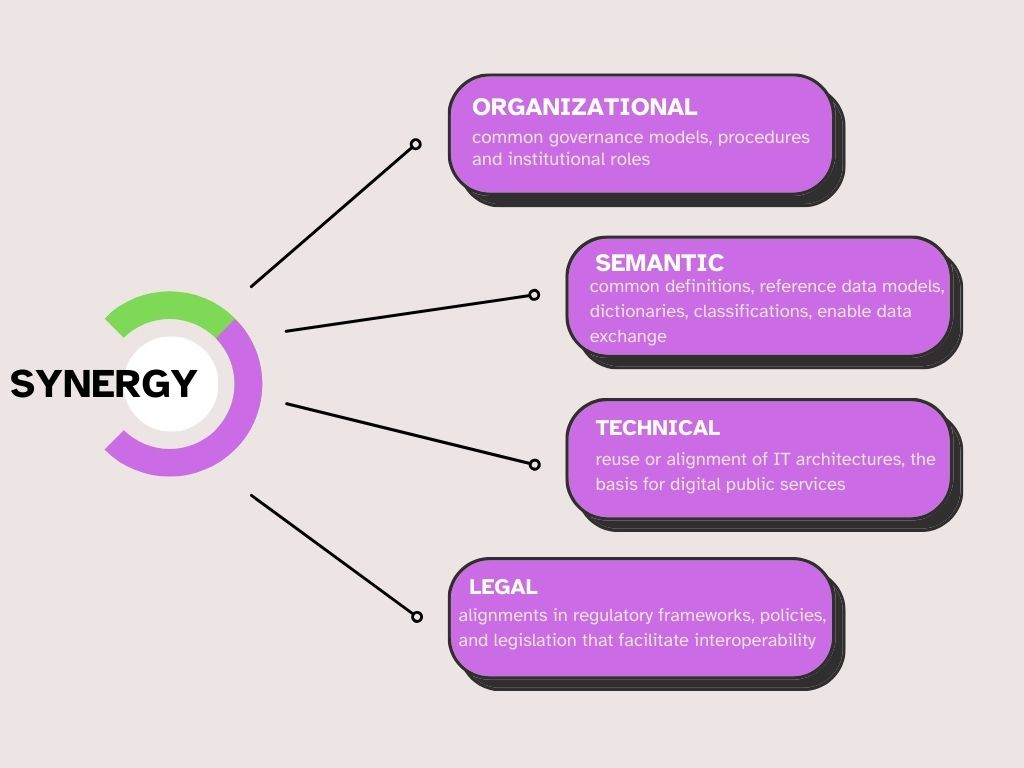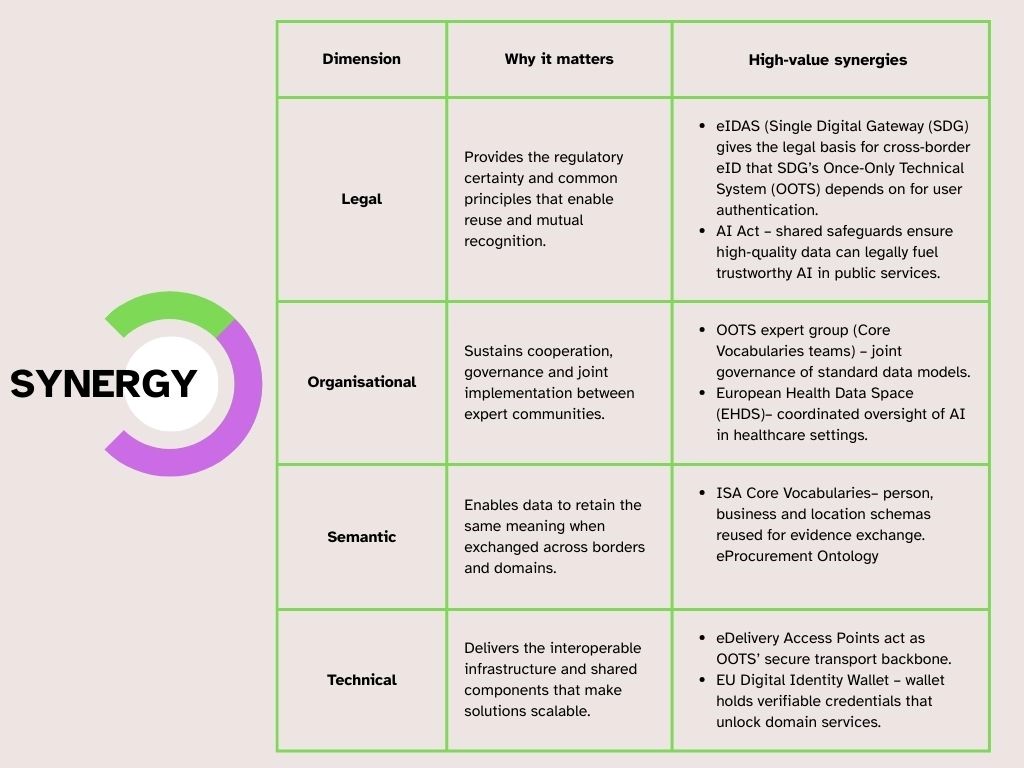
European and national initiatives, frameworks, and projects across various governance levels frequently share common objectives, reinforce each other, or address different aspects of the interoperability challenge. In the INVEST project, we have systematically mapped, analyzed, and compared existing European and national efforts that support digital transformation and cross-border data exchange within the public sector. Additionally, we have identified key synergies between initiatives operating at different governance levels. Recognizing synergies enhances our understanding of how the initiatives complement one another and jointly contribute to interoperability.
Our Approach
After a structured review of key initiatives relevant to cross-border interoperability, our analysis proceeded in 5 steps.

STEP 1
Each initiative was categorized into the following thematic areas:
- Digital transformation of public administration and public services
- Interoperability and data
- Trust and cybersecurity
- Innovative use of technology
STEP 2
Each initiative was categorized by geographical scope. We identified three categories based on geographical scope:
- National
- European
- Cross-country (two to five countries)
STEP 3
Each initiative was categorized by maturity level. Five maturity levels were defined:
- Incipient (ad hoc) – Unstructured, reactive and unpredictable
- Emerging (defined) – Basic structures and principles
- Established (governed) – Formalised processes and governance
- Advanced (optimised) – Data-driven decision-making, performance and scalability
- Leading (innovative) – Continuous improvement, industry benchmark, proactive innovation
STEP 4
Our analysis includes a reference to the Interoperable Europe Act (IEA), indicating how each initiative aligns with, or contributes to the objectives and principles of the Act. Each initiative was mapped to the four IEA elements:
- Governance – Establish a multi-level governance framework to define the interoperability agenda and ecosystem of common interoperable solutions. This framework will be led by the Interoperable Europe Council and supported by the Interoperable Europe Community.
- Interoperability assessment - Introducing mandatory interoperability assessments for interoperable-by-design public services. This will help public sector bodies to examine and, where appropriate, address cross-border aspects of interoperability-by-design. The Commission will provide the necessary guidance and tools.
- Sharing and reusing interoperability solutions between EU entities and public sector bodies, via the "Interoperability Europe Portal", a one-stop shop encouraging the sharing and reusing of high-quality and reliable interoperability solutions between public administrations.
- Innovation/support measures - reinforced innovation and policy support, including training, regulatory sandboxes for policy experimentation, GovTech projects and policy implementation support, to develop, test and scale solutions.
STEP 5
The final step was to identify synergies between initiatives to gain better understanding on how different initiatives complement each other and jointly contribute to cross-border interoperability.
The identified synergies have been grouped into four interlinked dimensions:

Identifying key synergies

Benefits of Synergistic Action
- Resource efficiency
Leveraging existing vocabularies, access points and legal tooling reduces integration time and funding needs for each new digital service. - Interoperability at source
Common data models and registries embedded in OOTS/data spaces ensure semantic consistency before national divergence can occur. - Faster time to service
Aligning pilot roadmaps (e.g., wallet + OOTS) avoids sequential roll outs and brings services to citizens sooner. - Market stimulation
Clear, harmonised rules (AI Act + Data Strategy) give GovTech vendors the certainty to build cross border solutions, growing the Single Market. - Trust & security
Unified identity, security and oversight mechanisms maintain citizen confidence in trans EU data sharing.
Why it matters
Identifying actions and initiatives that promote the consolidation and reuse of interoperable solutions across sectors, administrations and Member States, allows for a better understanding of how interoperability mechanisms evolve, interconnect and contribute to the development of sustainable, citizen-centric public services. This cross-sectoral perspective is further enhanced with the strategic identification of synergies, their recognition and practical utilisation —especially in cross-border and pan-European digital projects.
Ultimately, synergy among initiatives plays a crucial role in supporting innovation, enabling digital cohesion, supporting EU’s broader vision of interoperability as a driver of digital sovereignty, collaboration, and trust across Member States.

